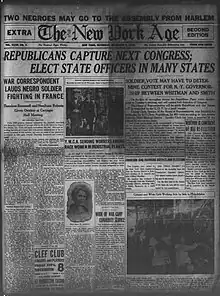The New York Age
The New York Age was a weekly newspaper established in 1887. It was widely considered one of the most prominent African-American newspapers of its time.[1]
| "The Afro-American Journal of News and Opinion" | |
 Cover of The New York Age on November 9, 1918 | |
| Type | African-American newspaper |
|---|---|
| Format | Weekly newspaper |
| Owner(s) | Timothy Thomas Fortune, Emanuel Fortune, Jr., and Jerome B. Peterson (1887–1907) Fred R. Moore (1907–1943) |
| Editor | Timothy Thomas Fortune |
| Founded | October 15, 1887 |
| City | New York, New York |
| Country | United States |
History
Origins
The New York Age newspaper was founded as the weekly New York Globe (not to be confused with New York's Saturday family weekly, The Globe, founded 1892 by James M. Place or the daily The New York Globe founded in 1904), an African-American newspaper that was published weekly from at least 1880 to November 8, 1884. It was co-founded by editor Timothy Thomas Fortune,[2] a former slave.[3]
1884–1887
The newspaper became the [New York] Freeman from November 22, 1884, to October 8, 1887, published six times weekly. It was co-owned by Jerome B. Peterson, who in 1904 was made the American consul in Puerto Cabello, Venezuela.[4]
1887–1960
On October 15, 1887, the newspaper officially became the weekly New York Age. Fred R. Moore bought the paper in 1907.[5] From 1953 to 1957, it was titled the New York Age Defender.
Gertrude Bustill Mossell worked at the New York Age from 1885 to 1889. W. E. B. Du Bois also worked there.[6]
The 1974 Reawakening of the African-American weekly
The New York Age, a firebrand fighter of racial injustice that died in the nineteen fifties, its zeal spent, was born again with its demeanor changed but its aim primarily the same. Adam C. Powell, the executive editor of the weekly newspaper, said that the paper would attempt to regain the eminence of the old Age, which was known during its heyday as the “distinguished black newspaper of opinion.” The initial press run of the paper in 1974 was 100,000 copies and it was sold at newsstands for 25 cents.[7]
Personnel
- Lester Walton (1882–1965), theater critic; he was a son-in-law of the publisher, Fred A. Moore
- Ludlow "Buster" Werner (né Ludlow Waymouth Werner; 1907–1967) became managing editor in 1929; he was a grandson of Fred Moore
- William A. Clarke, sports editor
- Chester R. Thompson, editor of the Brooklyn section
- Vere Johns contributed a column on The Arts
- James H. Hogans wrote news of railroad men and church doings
- Richard Durant, music critic
- Lewis E. Dial, sports
- Ebenzer Ray, special columns
- Bertram Baker, special columns
- Olive Arnold Adams [8]
References
- Encyclopedia of the Harlem Renaissance, Volume 2, pp. 901-02 (2004).
- Horner, Shirley. "ABOUT BOOKS", The New York Times, October 3, 1993. Accessed December 19, 2007. "Timothy Thomas Fortune, a pioneering black journalist, who went on to start The New York Age, once the nation's leading black newspaper, moved to Red Bank in 1901."
- H-Net.com: Review of Quigley, David. Second Founding: New York City, Reconstruction, and the Making of American Democracy Archived 2007-06-11 at the Wayback Machine (New York: Farrar, Straus and Giroux, 2004) ISBN 978-0-8090-8513-2
- (no headline - it's the tiny paragraph in the rightmost column on page 4, immediately above the clothing ad) in the Tacoma Times; published May 16, 1904 (via Chronicling America).
- "Moore, Fred R". Oxford African American Studies Center. Retrieved February 24, 2012.
- "PAL: Perspectives in American Literature - A Research and Reference Guide - An Ongoing Project". Archived from the original on 2011-06-24.
- "New York Age, a Black Weekly, Publishing Again (Published 1974)". The New York Times. 1974-04-21. ISSN 0362-4331. Retrieved 2020-10-14.
- "Spirit That Started Age Still Lives," by Olive Arnold Adams, New York Age Defender, Vol. 75, No. 24, August 27, 1955, pps. 1–2 (accessible via Newspapers.com, p. 1 and p. 2; subscription required)
External links
- New York Age at Chronicling America
- New York Age at fultonhistory
.com